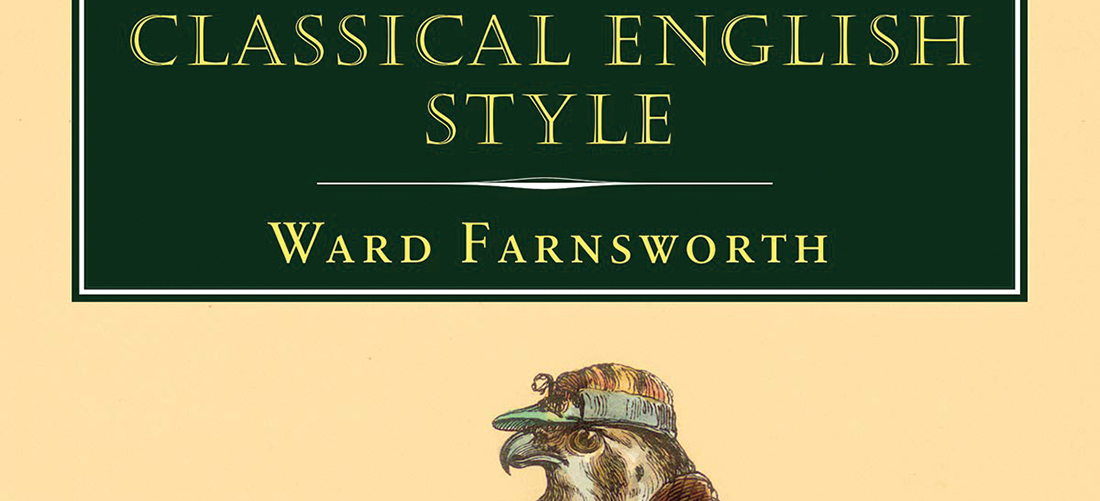
The Write Stuff
What makes memorable writing work?
By Stephen E. Smith
“These are the times that try men’s souls.” “The world will little note nor long remember . . .” “A date which will live in infamy . . .” “Mr. Gorbachev, tear down this wall.”
The right words arranged in the best order have always served to rally us in moments of crisis, and although we have, of late, been inundated with words beyond number, no one has assembled the vocabulary that sums up our deep sense of frustration. Farnsworth’s Classical English Style (2020 revised edition) is the third volume in a series that focuses on words, metaphor, rhetoric and style in English usage, and although the author doesn’t address the present failure of language, he goes far in explaining what makes specific semantic patterns enduring.
Farnsworth’s approach is straightforward. He parses great writing by great writers: Abraham Lincoln, Edmund Burke, Winston Churchill, William Shakespeare, Mark Twain, Charles Dickens, and many others whose eloquence survives even in our present circumstances — writers who understood the enduring principles of style but who were willing to violate those principles in the service of meaning and resonance.
Whereas most books on style offer formulas or impose a system for aspiring writers to follow, Farnsworth illustrates by use of example, citing short, familiar quotes to explain how memorable passages work. It is up to the reader to translate the lessons implicit in the writings of Lincoln or Churchill or in the King James Bible into a form that is acceptable in our times. Therein lies the benefit — and for the less disciplined reader, the rub. If you aren’t enthralled with language and its possibilities, the book is little more than a cure for insomnia. If, on the other hand, you’re a lover of words, Farnsworth’s latest offering might be just what the doctor ordered in the heart of a pandemic — a self-reflective occupation with the written word.
The opening chapters focus on word derivation with attention to the effects of Saxon and Latinate words, and how they shape meaning when used in opposition. “There are two ways to say almost anything in English: with little words or big ones,” Farnsworth writes. “More precisely, you can say most things with older, shorter words that have Germanic (or ‘Saxon’) roots, or with longer words that came into the language more recently — perhaps six or seven hundred years ago — from French, and before that from Latin.” Examples: ask/inquire; break/damage; luck/fortune; come/arrive, etc. Saxon words are short, direct, often one syllable, while Latinate words take prefixes and suffixes and are less likely to create an image in the reader’s mind — the visible vs. the conceptional.
Admittedly, there’s little new in this observation, and Farnsworth quotes English historian Thomas Macaulay, who detected, more than 100 years ago, the Latinate fault in the work of Samuel Johnson: “All his (Johnson’s) books are written in a learned language, in a language which nobody hears from his mother or his nurse, in a language in which nobody ever quarrels, or drives bargains, or makes love, in a language in which nobody ever thinks . . . ” Thus he cleverly employs Macaulay’s critique as both explanation and example.
Beyond this obvious observation, the reader is introduced to the more obscure nuances of word usage, demonstrating that the best writing — the most powerful writing — is a mix of Saxon and Latinate words, and he supplies and analyzes numerous passages from the King James Bible, Shakespeare, Lincoln and more. “Render therefore unto Caesar the things which are Caesar’s . . . .” “Sufficient unto the day is the evil thereof,” “Will all great Neptune’s ocean wash this blood clean from my hands?” “Ambition should be made of sterner stuff,” etc.
Many of the most recognizable passages begin with Latinate words and end with a strong series of Saxon words, as with Patrick Henry’s “I conceive it my duty, if this government is adopted before it is amended, to go home” — emphasizing the power created by word arrangements that stand in opposition to one another while keeping the demands on the reader (what Farnsworth calls “the cognitive load”) at a minimum.
The book’s central chapters explicate active and passive voice, sentence variations, and esoterica such as metonymy, anacoluthon, right- and left-branching, and direct and indirect approaches to the audience and situation, all of which are, despite the pedantic terminology, easily accessible.
The book’s final chapters, “Cadence: Classic Patterns” and “Cadence: Combinations & Contrasts,” which deal with prosody, the study of the stress and intonation in language, can be a trifle deadly — reminiscence of junior high English classes where you were tortured with scansions of Poe’s bouncy “The Raven” or Christopher Marlowe’s “Was this the face that launch’d a thousand ships. . . .” During a raging pandemic, who gives a rip about spondees and pentameters?
Still, Classical English Style is immensely entertaining, an indulgence for anyone wishing to escape the moment, and it’s worth a careful read, if for no other reason than it collects memorable quotes, a sort of Greatest Hits of clear and beautiful communication.
So where are the words we need to hear? Where is the unifying sentence or paragraph so necessary at this time in our shared distress?
It may have been uttered by George Floyd as he lay on the asphalt with a knee on his neck. Whether accidental metaphor or straightforward reality, “I can’t breathe” — a simple Saxon sentence that Farnsworth would find perfectly acceptable — may well sum up our collective state of mind, although it does nothing to lift us out of the funk in which we find ourselves. OH
Stephen E. Smith is a retired professor and the author of seven books of poetry and prose. He’s the recipient of the Poetry Northwest Young Poet’s Prize, the Zoe Kincaid Brockman Prize for poetry and four North Carolina Press awards.





